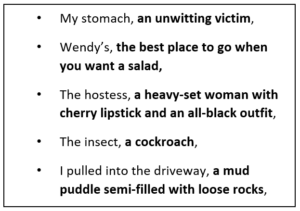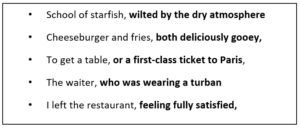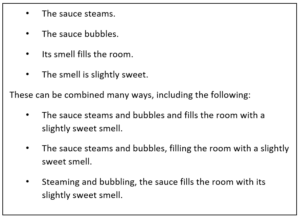This post was written by NCTE member Deborah Dean.
I grew up in classrooms with traditional grammar instruction—and I liked it. But, as a new teacher, I was advised to “teach grammar in context.” I remember reading Constance Weaver’s writing about the idea and thinking how great it sounded, weaving grammar into the course content rather than teaching it separately. But implementing grammar in context was harder than I’d anticipated. Maybe I was haunted by that grammar textbook on the shelf? How did I do all that AND teach writing at the same time?
I eventually shifted my guilty stance and worked out a way. For me, teaching grammar in context means considering what aspects of language would most benefit students’ current writing—so students need to be writing while I am teaching language.
My next decision is choosing what grammar to teach. My solution? A mix of considering genre, standards, and students’ knowledge. So, for example, if my eighth graders are writing restaurant reviews, I might consider teaching the following language elements during their writing:
- Appositives (prevalent in this genre)
- Commas to show pauses (in my state’s standards for 8th grade)
- Pronoun agreement (an issue in student writing on the last assignment)
Once I decide WHAT to teach, I need to figure out HOW to teach it. I learned to teach backwards.
An inclination for many teachers when we teach grammar is to start at the front, by defining the concept: An appositive is a word or phrase that renames another noun or noun phrase in a sentence. Ugh.
Instead, I start with inquiry into authentic examples from our mentor text study. Examples help students explore and identify a concept BEFORE it gets named, and students are much more likely to remember and apply the learning.
So, for example, I show a set of sentences from our mentor texts that use appositives (see an abbreviated example in the text box) and ask students what they notice about the bolded portions. After their noticings and discussion have helped them develop an understanding of what appositives look like (they are mostly short, 1 or more words), where they are placed (right beside a noun), and what they do (they describe/rename the noun they sit by)—then they are ready to hear the label. At that point, we can also discuss the effect of using appositives—why use them—so that students see value and purpose to the grammar.
the text box) and ask students what they notice about the bolded portions. After their noticings and discussion have helped them develop an understanding of what appositives look like (they are mostly short, 1 or more words), where they are placed (right beside a noun), and what they do (they describe/rename the noun they sit by)—then they are ready to hear the label. At that point, we can also discuss the effect of using appositives—why use them—so that students see value and purpose to the grammar.
 Sometimes, depending on the concept, I later share examples that help students learn to differentiate the concept I am teaching from other constructions that look similar, just to clarify their understanding. But either way, I work from examples back to the concept, rather than starting with the definition of the concept.
Sometimes, depending on the concept, I later share examples that help students learn to differentiate the concept I am teaching from other constructions that look similar, just to clarify their understanding. But either way, I work from examples back to the concept, rather than starting with the definition of the concept.
Sentence combining is another way we can weave grammar with writing. A daily practice that can help students understand important concepts about writing, sentence combining is a research-supported practice that improves writing. Generally, it helps students learn that
- writers have options in the way they structure their sentences (a concept most students find surprising when the realization hits them)
- different options create different effects—and writers choose one over another for those effects.
Sentence combining is not about making long sentences—it’s about making good ones. Students combine sets of sentences into one sentence, in multiple ways, as the example here shows.
To get the positive effects of sentence combining, teachers need to keep several principles in mind:
- Sentence combining is about playing and should not be graded or corrected. EVER.
- Teachers create sentence sets from the mentor texts students are studying for their writing.
- All sentence sets should be complete sentences.
- Students combine sentence sets into one sentence, in AT LEAST TWO DIFFERENT WAYS so that they see possibilities.
- Students should share their favorite combination aloud so that other students hear multiple options and discuss the different effects different constructions create.
- Students can look at the original sentence—but ONLY to consider why the author would have made the choice. NEVER to correct.
- Students consider how they might apply some of their combining learning in their polished writing.
Myhill et al. found that explicit teaching of grammar does improve student writing, especially when teachers employ a playful approach that involves lots of talk and clear connections to the writing students are doing. Exactly the kinds of instruction we can implement with a few shifts in stance!

Deborah Dean, formerly a secondary English teacher, is a professor of English at Brigham Young University, where she teaches preservice and practicing teachers about writing instruction. She is the author of What Works in Grammar Instruction; Strategic Writing: The Writing Process and Beyond in the Secondary English Classroom; Genre Theory: Teaching, Writing, and Being; What Works in Writing Instruction: Research and Practices, and the Quick Reference Guide (QRG) Teaching Grammar in the Secondary Classroom.
It is the policy of NCTE in all publications, including the Literacy & NCTE blog, to provide a forum for the open discussion of ideas concerning the content and the teaching of English and the language arts. Publicity accorded to any particular point of view does not imply endorsement by the Executive Committee, the Board of Directors, the staff, or the membership at large, except in announcements of policy, where such endorsement is clearly specified.

